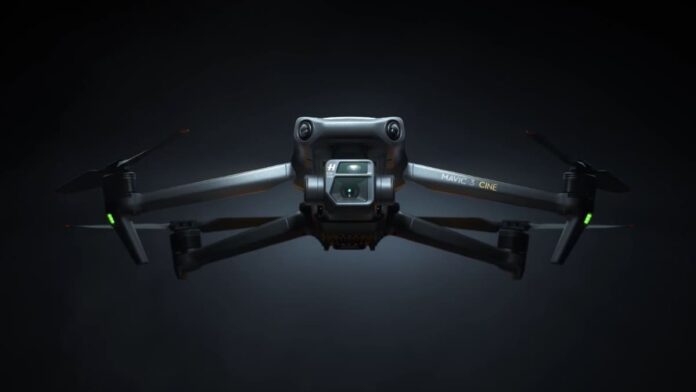DJI Mavic 3 and Mavic 3 Cine have been unveiled as the latest drones from the Chinese company. The new Mavic models come as the successors to the Mavic 2 Pro and Mavic 2 Zoom that both were launched back in 2018. Both Mavic 3 and Mavic 3 Cine share the same design with omnidirectional obstacle sensing and offer a dual camera system backed by Swedish optics maker Hasselblad. In terms of differences, the Mavic 3 Cine offers an upgraded experience with Apple ProRes 422 HQ support and built-in 1TB SSD.
DJI Mavic 3, Mavic 3 Cine price
DJI Mavic 3 price starts at $2,199 (roughly Rs. 1,63,400) for the Mavic 3 Standard version that comes with the drone, a battery, RC-N1 remote controller, three RC-N1 cable, battery charger, storage cover, and three pairs of propellers. The Mavic 3 also comes in a DJI Mavic 3 Fly More Combo option that is priced at $2,999 (roughly Rs. 2,22,800) that brings two batteries, a battery charging hub, five pairs of propellers, ND filter set (ND4/8/16/32), and a convertible carrying bag in addition to all that is bundled with the Standard version.
The DJI Mavic 3 Cine is priced at $4,999 (roughly Rs. 3,71,400). It is available under the DJI Mavic Cine 3 Premium Combo that brings the special-edition drone with built-in 1TB SSD, three batteries, DJI RC Pro, battery charger, battery charging hub, storage cover, six propeller sets, ND filters ND4/8/16/32 and ND6/128/256/512, convertible carrying case, and a DJI 10Gbps data cable.
Initially, the DJI Mavic 3 series is available for orders in the US through the DJI website as well as authorised retail partners.
DJI Mavic 3, Mavic 3 Cine specifications
The DJI Mavic 3 and DJI Mavic 3 Cine both come with the same, customised L2D-20c aerial camera that houses a 4/3 CMOS sensor with a 24mm prime lens, which delivers 84-degree field of view. The camera system also includes a secondary camera sensor that has a 162mm tele lens with 28x Hybrid Zoom and f/4.4 aperture. Overall, the camera system supports an adjustable aperture of f/2.8–f/11 and a native dynamic range of 12.8 stops. It is powered by Hasselblad software algorithms that enables 20-megapixel still images in 12-bit RAW format and videos in 5.1K at 50fps and 4K at 120fps.
On the part of distinction, the DJI Mavic 3 Cine has Apple ProRes 422 HQ encoding for a maximum data rate of 3772Mbps. The enhanced version also has 1TB SSD. The regular Mavic 3, on the other hand, has 8GB of onboard storage.
Except for the premium video encoding and additional storage space, the Mavic 3 Cine is identical to the Mavic 3.
DJI claims that the Mavic 3 delivers a deeply accurate colour palette that comes from Hasselblad Colour Solution (HNCS). The drone also has the ability to capture up to a billion colours using the 10-bit D-Log colour profile.
The Mavic 3 is also capable of shooting videos in standard H.264 and H.265 profiles.
Alongside the enhanced camera capabilities, the Mavic 3 includes APAS 5.0 that takes inputs from six fish-eye vision sensors and two wide-angle sensors into consideration continuously sensing obstacles. The obstacle sensing system also will also get the upgraded ActiveTrack 5.0 through an update in January that will enable sensing of obstacles even in Normal mode. It will also help the drone move forward, backward, left, right, and diagonally, and fly alongside as well as around a particular moving subject.
DJI claims the proprietary technology is capable of tracking and framing the subject even if it moves too fast and temporarily goes out of frame. Further, the drone has an advanced positioning algorithm that helps improve hovering precision using GLONASS and BeiDou satellites.
The DJI Mavic 3 also has an integrated AirSense system that was featured in the DJI Air 2S earlier this year. It warns pilots of nearby airplanes and helicopters transmitting ADS-B signals to help them fly the drone to a safer location.
For safely returning back, the Mavic 3 includes the company’s in-house Return to Home (RTH) system that automatically directs the drone back to its starting point if it runs critically low on battery or loses connection to the controller. It also has an update to the existing RTH system that enables the new model to determine the shortest, safest, and energy-efficient route to land back at its home point.
The Mavic 3 includes an upgraded transmission system that supports flying with a strong signal interference on a range of 15 kilometres, DJI said. The drone is also the company’s first drone to offer a High Frame-Rate Transmission with a 1080p/60fps live feed using the system called O3+.
Pilots can capture high-quality videos through the Mavic 3 that can be shared with others after automatic editing and dubbing through the MasterShots feature. There is also a Panorama mode that allows pictures to be directly stitched and processed by the drone, without using the DJI Fly app or any other post-production solution. Additionally, the drone comes with QuickTransfer over Wi-Fi 6.
The Mavic 3 packs a 5,000mAh battery that is rated to deliver up to 46 minutes of flight time on a single charge, in ideal conditions. It is a significant upgrade over the original Magic 2 that had a 31-minute battery life. The new drone has also improved structure that is foldable.
In terms of weight, the regular Mavic 3 has a take-off weight of 895 grams, while the Mavic 3 Cine comes is 899 grams weight.
Source link


